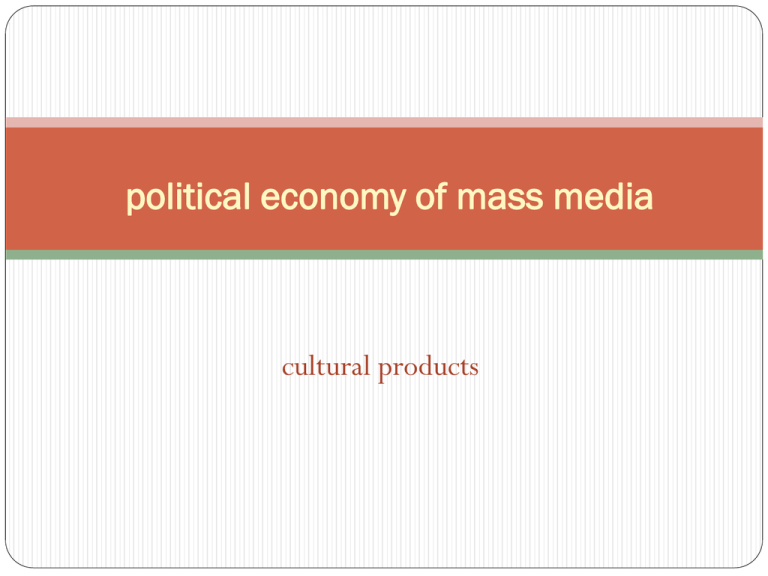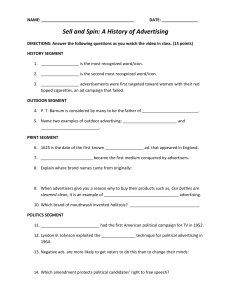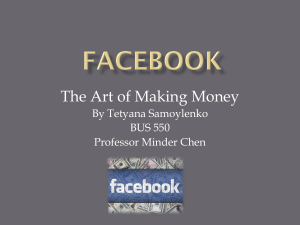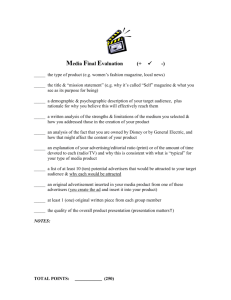Political Economy
advertisement

political economy of mass media cultural products political economy school considering issues of the nature and effects of the system of production of media and information the focus in US-based political economy of communication tends to emphasize the economic side of equation with focus on ownership, corporatization, and consumption while in Britain there has been a spotlight of the political dimension, with emphasis on public service broadcasting, the importance of state supported and regulated communications, and the politics of broadcasting - Noam Chomsky & Edward Herman examined the influence of market forces on media content, developing what they term a ‘propaganda model’ of the news that connects corporate and state power in a regulatory nexus exploding prevailing myths of US journalism that rest on ideas of pluralism and free agency in a democratic society, Herman and Chomsky demonstrate that the free-market economics model of media leads inevitably to normative and narrow reportorial frames core point media tend to marginalize dissent and allow the government and dominant private interests to get their messages across the public in ways that promote hegemonic constructions and suppress oppositional voices they remind us that in a nominal democracy with serious inequalities of wealth and power, the media can function to manufacture consent to policies that rarely represent the voices or interests of the majority of citizens - Herbert Schiller Schiller applied critical lens to the examination of the role of popular culture in the spread of American dominance illuminating the links between cultural and hegemonic processes core point the expansion of the capitalist market is a metamorphosis and expansion of the system of economic domination and consumption arguing against the claim that global culture represents a field of diversity, heterogeneity, and difference, Schiller argues that US media cultural dominance continues rapidly and that corporate transnationalism and not an amorphous globalism is the dominant economic force of the present moment - Dallas Smyth focuses on media consumption: the audience of the media in the act of consumption constitutes, exchange value none of the literature on economics or political economy deals with the role of the markets for audiences, produced by the mass media, bought and used by advertisers core point revisions the audience’s role in the system as unpaid work in the service of the advertising industry among the first to examine the connection between the apparently non-advertising content of the media with the paid advertisements, noting the symbiotic relationship between these two supposedly separate functions - Nicholas Garnham attempted to counter charges of economic reductionism and determinism by offering a revision of base/superstructure model in an attempt to connect media and culture with developments within industrial capitalism, and thus rethink relations between economics and culture his significant intervention is the idea that cultural artifacts are social and materialist phenomena articulated to specific historical moments in capitalist development and thus variable and shifting core point the production and dissemination of mass culture is rooted in the material dimension we must distinguish between the media as processes of material production on the one hand, and as sites of ideological struggle on the other, and the relationship between those two levels or instances • cultural industries institutions that employ the characteristic modes of production and organization of industrial corporations to produce and disseminate symbols in the form of cultural goods and services as commodities competition drives the search for profits via increased productivity … cultural products … and their contradictory nature novelty, difference (maximize audiences) public goods (difficulty to establish scarcity) economic foundation the mass media are expensive to set up and operate; the equipment and facilities require major investment to meet their expenses, the mass media sell their products in two ways derive income from selling a product directly to mass audiences, as do the movies, record and book industries derive income from advertisers who place advertisements for mass audiences that the media provide, as do radio and television advertising revenue advertisers pay the mass media for access to potential customers from print media advertisers buy space, from broadcasters they buy time generally, the more potential customers a media company can deliver to advertisers, the more advertisers are charged for time or space … trends book publishers once relied solely on readers for revenue, but that has changed; today book publishers charge for film rights whenever Hollywood turns a book into movie or a television program – profit indirectly from advertising revenue until 1950s movies relied on box-office receipts for profits, but moviemakers now calculate what profits they can realize from recycling their movies through advertising-supported television and home videos; they even pick up advertising directly by charging commercial companies to include their products in the scenes they shoot direct audience payments have emerged in broadcasting; cable subscribers pay a monthly fee (audience support is the basis of subscription television) economic imperative economics figure into which messages make it to print or the airwaves to realize their profit potential, the media that seek large audiences choose to deal with subjects of wide appeal and to present them in ways that attract great numbers of people this is a function of economics for those media that depend on advertising revenue to stay in business even media that seek narrow segments of the population need to reach as many people within their segments as possible to attract advertisers implications the drive to attract audiences affect media messages the economic dependency of the mass media on advertising income gives considerable power to advertisers (who can threaten to yank advertising out of a publication if a certain negative story appears) lack of advertiser support can work against certain messages (not to be appeared in media) advertising affects media content itself in many ways (quantitatively and qualitatively) media conglomeration combining of companies into larger companies; giant corporations with diverse interests have consolidated the mass media into relatively few hands media ownership consolidation: involves a process of mergers, acquisitions and buyouts (horizontally, vertically) media ownership collaboration: the dominant giant companies have joint complex deals, having thus intertwined interests … issues corporate strategies often sacrifice quality content and public service on the altar of increasing profits lack of diverse coverage (sharing stories via news agencies reduces the cost) sameness, imitation of what is already popular anti-intellectualism; gatekeepers have unprecedented power to control media content corporate instability; profit-driven companies are quick to sell subsidiaries that fall short of profit expectations transnational ownership media conglomerates that have acquired extensive media holding in national level extend their reach into other countries media monopoly and, the global audience … considerations potential threat to the cultural autonomy and the free flow of information and ideas or, respect of national characteristics, adapting to local cultures? media melding the different mass media are moving into digital transmission; this technological melding is being accelerated by the continuing consolidation of companies that own mass media digitization: a process that compresses, stores and transmits data, including text, sound, and video in extremely compact and efficient ways policy concerns mass media, their economies of scale, and their role as facilitators of democracy … * notes from the books: - Durham, M. G. and Kellner, D. (eds.) (2006) Media and Cultural Studies: Key - Works (revised edition) Garnham, N. (1990) Capitalism and Communication Gurevitch, M. Bennet, T., Curran, J. and Woollacott, J. (eds.) (1982) Culture, Society and the Media Herman, E. and Chomsky, N. (1988) Manufacturing Consent: the Political Economy of the Mass Media McChesney, R. (2001) Rich Media, Poor Democracy: Communication Politics in Dubious Times (new edition) Mosco, V. (1996) The Political Economy of Communication: Rethinking and Renewal Schiller, H. (1991) ‘Not yet the post-imperialist era’, in Critical Studies in Mass Communication, 8 Thussu, D. (2000) International Communication: Continuity and Change coming next week … Cultural Studies key text: Williams, R. (1958/1983) Culture and Society 17801950, 2nd edition. Columbia University Press (Introduction, ch.5 of part III) thank you for your attention questions for discussion which is more important for Turkish mass media – profits or serving the public? do you know any types of mass media not dependent on advertising or consumer purchase? workshop let’s say that you have the capital to run a business, and you want to enter the mass media market (in Turkey) can you think of possible ways to do it? a few things about your strategy and, your perspective



